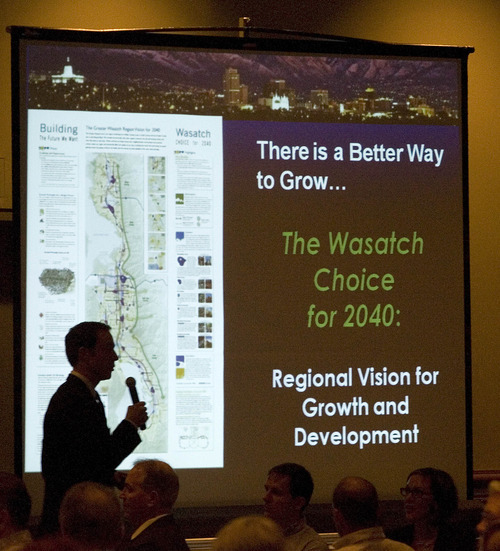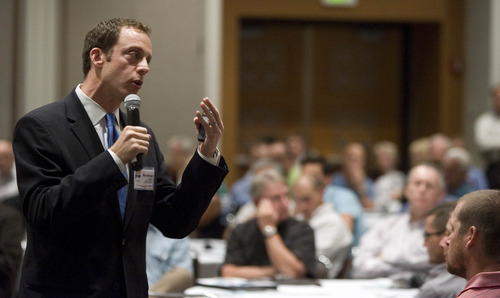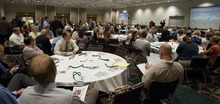This is an archived article that was published on sltrib.com in 2011, and information in the article may be outdated. It is provided only for personal research purposes and may not be reprinted.
Imagine a different-looking Utah in 30 years. Instead of expanding suburban sprawl with single-family homes, people would start to cluster in new town centers around mass-transit stations that replaced old run-down areas.
Many would live in buildings that have businesses on the first floor, offices on the second and residences above that. Town centers would be designed to allow people to live, work and play in the same area, so they would drive less and walk or bike more.
More than 300 elected officials, planners, business leaders and representatives of ethnic groups met Monday at the Calvin L. Rampton Salt Palace Convention Center to launch implementation of a plan to achieve such a future, called the Wasatch Choice for 2040 plan, which they helped develop over the past decade.
"Over the next 30 years, we're projecting that we will add another 1.4 million people along the Wasatch Front," an increase of 65 percent, said Andrew Gruber, executive director of the Wasatch Front Regional Council. "The way we handle that growth will have an impact on our quality of life and economy."
He said that continuing the types of developments that have occurred in the past are not an option because of the traffic congestion, pollution and loss of open space they would bring.
He said if most development continued to aim for traditional single-family homes in suburbs, studies predict that traffic here would increase from 49 million miles a day now to more than 90 million in 30 years.
"If we keep going the way we are, there will be a lot more traffic congestion in 2040," he said. He added there is little space to try to add new highways and freeways in valleys bounded by mountains and lakes, so moving more people to mass transit is essential.
To avoid an estimated loss of 300 square miles of open space along the Wasatch Front, the Wasatch Choice 2040 plan envisions "filling in" some areas that may be run-down now with new, higher-density developments attracted by mass transit stops.
To reduce traffic congestion and pollution, the town centers would have recreation, work and residences in the same area, and allow easy walks or biking to them.
Gruber said surveys show 75 percent of Utahns want to live in such communities. "The problem is we don't have close to the supply to meet those demands," he said.
The U.S. Department of Housing and Urban Development provided a $5 million grant to help the Wasatch Choice for 2040 Consortium make solid plans on how to make its vision real — so it called the hundreds of officials together on Monday to help.
"It's one thing to have a vision and another to actually have a reality," Gruber said.
"It will take all of us working together," Salt Lake County Mayor Peter Corroon told the group.
Lt. Gov. Greg Bell said the process is working the correct way, by involving everyone at ground level to look at what must be done. "Working from the bottom up is messy and hard. It's easier to be a dictator … but it doesn't work," he said.
Officials divided into small groups to talk and write about concerns and try to identify problems that must be overcome to achieve the vision.
Gruber said, for example, that traditional zoning must change and be more innovative. Instead of separating commercial and residential areas, it probably must allow combined use and look instead at what type of structures and heights may be allowed in an area.
He noted that regional transportation plans have already embraced the vision that officials seek, and is putting far more emphasis on new transit — including new TRAX lines, commuter rail, streetcars and bus rapid transit — than it is on new freeways or highways.
Gruber said "demonstration areas" have also been identified to experiment with trying to implement the new vision.
They are around the Salt Lake City Central Intermodal Hub; South Salt Lake; the Salt Lake streetcar area; Magna; the Provo Intermodal Hub; and Sandy.
The consortium of officials plans continuing meetings over the next two years to work on implementation plans. —
Wasatch Front future
Estimates of a 65 percent increase in population mean Utahns need to begin planning now to avoid their children and grandchildren becoming mired in traffic jams, pollution and an urban landscape largely devoid of open space.







